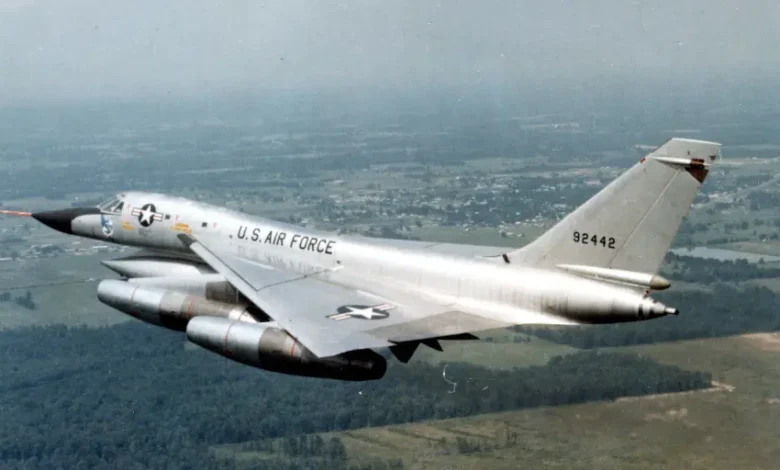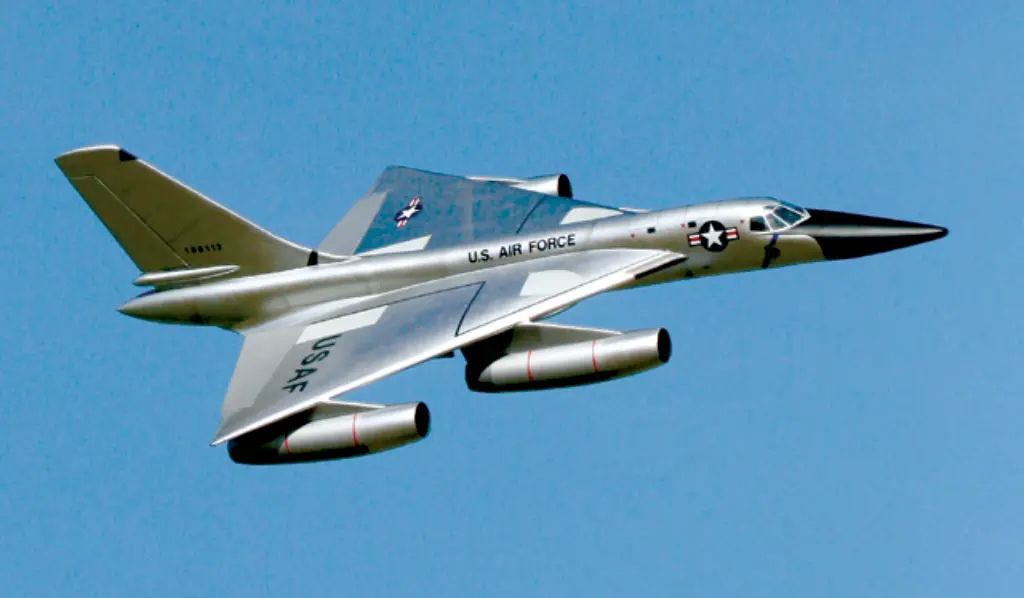Convair B-58 Hustler

The Convair B-58 Hustler was the first operational supersonic bomber capable of Mach 2 flight. Introduced in 1960, it was designed for high-speed, high-altitude nuclear strike missions during the Cold War. Known for its sleek delta-wing design and advanced avionics, the B-58 was a technological marvel of its time but had a relatively short service life due to high operational costs and the advent of intercontinental ballistic missiles (ICBMs).
Fact Sheet
| Role | Supersonic Strategic Bomber |
|---|---|
| Manufacturer | Convair |
| First Flight | November 11, 1956 |
| Service Entry | 1960 |
| Crew | 3 (pilot, navigator, defensive systems operator) |
| Number Built | 116 |
Specifications (B-58A Model)
| Length | 96 ft 10 in (29.5 m) |
|---|---|
| Wingspan | 56 ft 10 in (17.3 m) |
| Height | 29 ft 11 in (9.1 m) |
| Wing Area | 1,542 sq ft (143.3 m²) |
| Empty Weight | 55,560 lb (25,200 kg) |
| Loaded Weight | 163,000 lb (74,000 kg) |
| Max Takeoff Weight | ~176,890 lb (80,260 kg) |
| Powerplant | 4 × General Electric J79-GE-5A turbojet engines (15,600 lbf each with afterburner) |
| Max Speed | 1,325 mph (2,132 km/h, Mach 2.0) |
| Cruise Speed | 610 mph (980 km/h) |
| Range | 4,100 mi (6,600 km) with external fuel tanks |
| Service Ceiling | 63,400 ft (19,300 m) |
| Rate of Climb | 4,900 ft/min (25 m/s) |
Armament & Defensive Equipment
| Guns | 1 × 20 mm M61 Vulcan cannon in tail turret |
|---|---|
| Bomb Load | Up to 19,450 lb (8,820 kg) of nuclear weapons |
| Aiming Equipment | AN/ASQ-42 bombing/navigation system |
Notable Features
- First operational bomber capable of sustained Mach 2 flight
- Delta-wing design for high-speed performance
- Advanced avionics and inertial navigation system
- Carried nuclear payloads in a detachable pod
- Short service life due to high costs and changing strategic needs

Convair B-58 Hustler: The Brief, Brilliant Reign of the Supersonic Bomber
The Convair B-58 Hustler was a groundbreaking American supersonic strategic bomber that served briefly but spectacularly as a key component of the United States Air Force’s (USAF) Strategic Air Command (SAC) during the Cold War. Renowned for its unparalleled speed and distinctive delta-wing design, the B-58 represented a daring leap forward in aviation technology, pushing the boundaries of what was thought possible for a bomber.
B-58 Development & The Supersonic Imperative
The B-58’s genesis lay in a 1947 requirement from the newly formed USAF for a medium bomber that could cruise at high speeds and carry a nuclear payload over significant distances. Early studies explored various unconventional designs, including “parasite” concepts that would be carried by larger aircraft. However, by the early 1950s, Convair, drawing on its expertise with delta-wing aircraft (like the F-102 Delta Dagger), solidified a design for a standalone supersonic bomber.
The B-58 was designed to penetrate Soviet airspace at high altitudes and supersonic speeds (Mach 2+), relying on speed rather than defensive armament for survivability. The first XB-58 prototype flew on November 11, 1956, and the aircraft officially entered operational service with SAC in March 1960. A total of 116 B-58 Hustlers were built, including prototypes and production models.
B-58 Design Features: The Need for Speed
Every aspect of the B-58’s design was optimized for supersonic performance:
- Delta Wing: The most striking feature was its large, thin, highly swept delta wing with a 60-degree leading-edge sweep. This design was ideal for high-speed flight but made low-speed handling challenging.
- Area Rule Fuselage: The B-58 incorporated the “area rule” concept, which dictated a “waisted” or pinched fuselage shape where the wings attached, to reduce transonic drag and enable smoother passage through the sound barrier.
- Four General Electric J79 Afterburning Turbojet Engines: The Hustler was powered by four powerful J79 engines, each producing up to 15,000 lbs of thrust with afterburner. These engines, mounted in individual pods beneath the wings, propelled the B-58 to a maximum speed exceeding Mach 2 (over 2,100 km/h or 1,300 mph), making it the fastest bomber in the world during its service.
- Unique Underbelly Pod: Due to its thin fuselage (dictated by supersonic design), the B-58 could not carry bombs internally in the traditional sense. Instead, it carried its primary payload (a nuclear weapon and additional fuel, or reconnaissance equipment) in a large, jettisonable two-component pod beneath the fuselage. This pod was designed using the area rule as well.
- Three-Man Crew: The B-58 had a crew of three, seated in tandem: pilot, navigator/bombardier, and defense systems operator.
- Escape Capsules: To ensure crew survival at supersonic speeds and high altitudes, each crew member was provided with an individual ejection capsule, a significant safety innovation that protected them from the extreme forces and environments during an ejection.
B-58 Avionics & Armament: Minimalist but Mighty
The B-58’s mission profile dictated its armament and sensor suite:
- Primary Nuclear Weapon Carrier: The B-58’s main offensive capability was its single nuclear weapon carried in the jettisonable pod. Later modifications (1961-1963) allowed it to carry additional smaller nuclear weapons (B43 or B61) on two tandem stub pylons under each wing, increasing the total potential nuclear payload to five.
- Defensive Armament: The only defensive weapon was a single 20 mm M61 Vulcan cannon mounted in a remotely controlled, radar-directed tail turret. The reliance was on speed and altitude for evasion.
- Inertial Navigation System: The B-58 was equipped with a sophisticated inertial guidance navigation and bombing system, allowing for precise targeting at high speeds and altitudes.
B-58 Variants & Upgrades
While the B-58 did not have a large number of production variants, testing and proposed upgrades were constant:
- XB-58 / YB-58A: Prototypes and service test aircraft.
- B-58A: The primary production bomber variant, all 86 operational aircraft were of this type.
- RB-58A: Reconnaissance variants, converted from YB-58As and used for various test programs.
- TB-58A: Trainer variants, converted from early production and test aircraft.
- NB-58A: One YB-58A was modified to test the General Electric J93 turbojet engine for the XB-70 Valkyrie program.
- B-58B (Proposed): An improved variant with more powerful engines and proposed canard surfaces, but ultimately canceled.
B-58 Combat History: Deterrent in the Cold War
Despite its cutting-edge design and impressive performance, the B-58 Hustler never saw combat or dropped a bomb in anger against an enemy. Its role was purely one of nuclear deterrence during a critical period of the Cold War.
- Strategic Nuclear Deterrence: From 1960 to 1970, the B-58 was a high-profile asset for SAC, maintaining a constant readiness to deliver nuclear strikes. Its ability to achieve Mach 2 at high altitudes was intended to make it impervious to Soviet interceptors and early surface-to-air missiles.
- Record Breaker: The B-58 set numerous world speed and altitude records, winning multiple prestigious aviation trophies, including the Bendix and Mackay Trophies. For example, in 1962, a B-58 set multiple speed records flying from Los Angeles to New York and back.
- Vulnerability Shift: The B-58’s primary advantage—high-altitude supersonic speed—was rapidly countered by the development and widespread deployment of effective Soviet high-altitude surface-to-air missiles (like the SA-2 Guideline) by the mid-1960s. This forced a doctrinal shift to low-altitude penetration, a role for which the B-58 was not ideally suited, as its thin delta wing led to a rough ride and high fuel consumption at low altitudes, significantly reducing its already limited range.
B-58 Retirement & Legacy
The B-58’s career was remarkably short, especially for a strategic bomber. Its high operating costs, limited range at low altitudes, high maintenance requirements (it was 40% more expensive to operate per flying hour than the B-52), and a concerning accident rate (26 of 116 aircraft were lost, often during flight tests) led to its early retirement.
The B-58 was gradually phased out of SAC service, being fully replaced by the conventional-capable B-52 and the new FB-111, which was designed for low-altitude penetration. The last B-58 Hustler was retired on January 16, 1970, with all remaining aircraft flown to the “Boneyard” at Davis-Monthan AFB in Arizona for storage and eventual scrapping.
Today, only eight B-58 Hustlers survive as museum pieces. Despite its short operational life, the B-58 left an indelible mark on aviation. It pushed the boundaries of supersonic flight, validated the delta-wing concept for high-speed aircraft, and influenced the design of subsequent bombers and even commercial airliners. It remains a visually stunning testament to the intense technological race of the Cold War.



